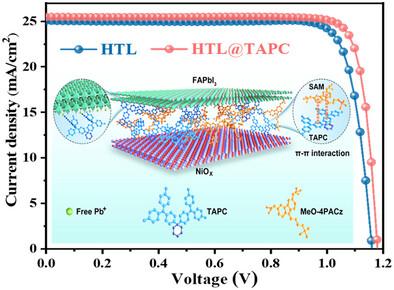高性能稳定倒钙钛矿太阳能电池的埋藏界面改性研究
IF 16.9
1区 化学
Q1 CHEMISTRY, MULTIDISCIPLINARY
引用次数: 0
摘要
残余应力会引起钙钛矿晶格畸变,导致位错、空位等局部缺陷的形成。这些缺陷作为非辐射复合中心,显著影响钙钛矿薄膜的稳定性。在本研究中,三苯胺衍生物(TAPC)被设计为一种有效的钝化剂。所得到的修饰分子层在空穴传输层(HTL)和钙钛矿之间建立了热膨胀系数的梯度排列,有效地减轻了钙钛矿膜内的应力积累。这种改进同时增强了空穴输运能力并优化了能级对准。优化后的钙钛矿太阳能电池(PSCs)的功率转换效率(PCE)从24.22%提高到26.05%,填充因子(FF)从83.2%提高到85.2%。此外,该器件实现了1.55 eV带隙psc中最低的开路电压(Voc)损耗,同时保持了优异的长期稳定性。重要的是,该策略还使相应的柔性PSC (F - PSC)实现了24.39%的显着PCE。总的来说,这些结果为钙钛矿薄膜的埋藏界面改性和高性能F - psc的制造提供了一条有希望的途径。本文章由计算机程序翻译,如有差异,请以英文原文为准。

Buried Interface Modification for High Performance and Stable Inverted Perovskite Solar Cells
Residual stress can cause distortion of the perovskite lattice, resulting in the formation of local defects such as dislocation and vacancy. These defects serve as non‐radiative recombination centers and significantly affect the stability of perovskite films. In this study, triphenylamine derivative (TAPC) was designed as an effective passivating agent. The resulting modified molecular layer established a gradient arrangement of thermal expansion coefficients between the hole transport layer (HTL) and the perovskite, effectively mitigating stress accumulation within the perovskite film. This modification concurrently enhanced hole transport capability and optimized the energy level alignment. Consequently, the power conversion efficiency (PCE) of the optimized perovskite solar cell (PSCs) increased from 24.22% to 26.05%, with the fill factor (FF) rising from 83.2% to 85.2%. Furthermore, the device achieved the lowest open‐circuit voltage (V oc ) loss reported for comparable 1.55 eV bandgap PSCs, while maintaining excellent long‐term stability. Importantly, this strategy also enabled a corresponding flexible PSC (F‐PSCs) to achieve a remarkable PCE of 24.39%. Collectively, these results demonstrate a promising pathway for buried interface modification of perovskite films and the fabrication of high‐performance F‐PSCs.
求助全文
通过发布文献求助,成功后即可免费获取论文全文。
去求助
来源期刊
CiteScore
26.60
自引率
6.60%
发文量
3549
审稿时长
1.5 months
期刊介绍:
Angewandte Chemie, a journal of the German Chemical Society (GDCh), maintains a leading position among scholarly journals in general chemistry with an impressive Impact Factor of 16.6 (2022 Journal Citation Reports, Clarivate, 2023). Published weekly in a reader-friendly format, it features new articles almost every day. Established in 1887, Angewandte Chemie is a prominent chemistry journal, offering a dynamic blend of Review-type articles, Highlights, Communications, and Research Articles on a weekly basis, making it unique in the field.

 求助内容:
求助内容: 应助结果提醒方式:
应助结果提醒方式:


